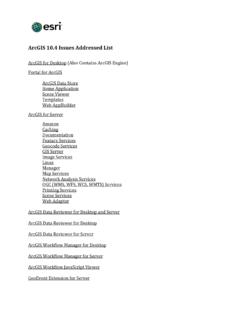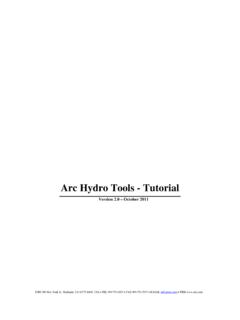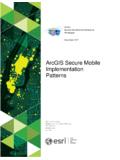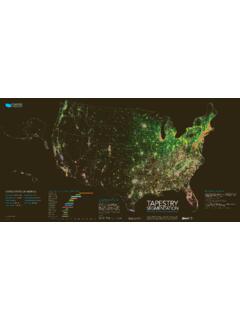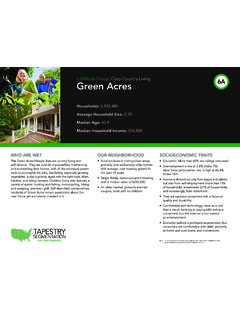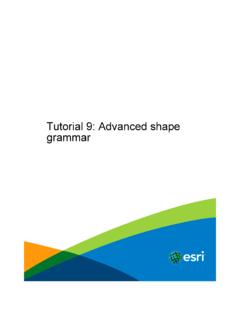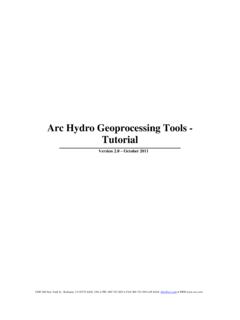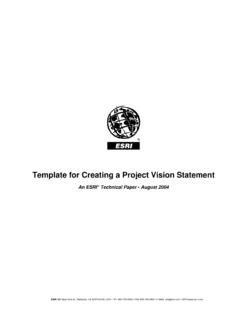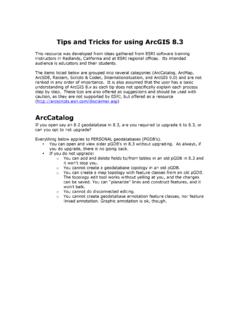Transcription of ArcGIS Data Models: Water Utilities
1 Water UtilitiesArcGIS Data ModelsWater Utilities $ in USAArcGIS Water Utilities Data ModelESRI 380 New York Street Redlands, CA 92373-8100 USA909-793-2853 FAX 909-793-5953 ArcGIS Data Models9 781589 480308 ISBN 1-58948-030-9 Steve Grise, Eddie Idolyantes,Evan Brinton, Bob Booth,and Michael ZeilerGrise, Idolyantes, Brinton, Booth, Zeilerg 2 2 PHHH PHHI2i se 2 2 2 2 2 2 2 2e 2 2 2 2 2 # 2 2 2 $ # 2 2 2i s 2 2% &2 2 2# 2 2 2 %2 2 2 2 2 2 2 2x 2 2 2 2% &2 2 2 # 2 2 2 2 2 2 2 2 D2 2 2 D2 # 2 2 2 D2 2 2 2 2 2 2 D2 $ 2 2 $ 2 2 2% 2 2i s 2e 2 *# 2 # 2 2 2 e X2g 2w D2i sD2 QVH2x %2 &2 D2 D2ge2 WPQUQEVIHHD2 e 2 2 2 2 2 # 2 2 # 3 2 2 2% # 2 2qy i xwix 2 i sg ihGvsws ih2 sqr e 2 % D2 # D2 G 2 2 2 # 2 2 # 3 2 2 2 2 2 2v 2e 2s 2 2 2 2 2q 2 *# 2 2 2 i sg ihGvsws ih2 sqr 2e 2 2 # D2# D2 # D2 # 2 2 2 2q 2 2 # 3 2 2 2 2 2 2 2pe 2:SP PPUEIR2e 2sD2ssD2 2sss2@t xIWVUAY2pe 2:SP PPUEIW2@t x2 IWVUA2 G 2pe 2:IP PIIGIP PIP2@g 2 2h Gg # 2 % AY2 hpe 2:PSP PPUEUHIS2@xy 2 IWWSA2@ 2h A2 G 2hpe 2.
2 PPU UPHP2@g # 2 % AD2 2 g Gw # # 2 2i sD2 QVH2x %2 &2 D2 D2ge2 WPQUQEVIHHD2 e i sD2 2i s2 2 D2 2e sw 2 2 & 2 2i sD2 2 2 2 2 2 2 2 # Y2 2 2 2 2 2i# 2g # 2e qs D2e s D2e g D2e w D2e hiDe y 3 D2e D2qs 2 2i sD2 2 2e qs 2 2 2 & 2 2%%% 2 2 2 2 & 2 2i s y 2 2 2 # 2 2 2 2 & 2 2 2 & 2 2 2 2 & % , 8:21 vCHAPTER 1: MODELING WITH THE ArcGIS Water Utilities DATA MODEL .. 2 Modeling concepts in ArcGIS 3 Water 4 CHAPTER 2: DEPLOYING THE ArcGIS Water DATA MODEL .. 9 The process of deploying ArcGIS 10 Geodatabase design, tools, and 13 ArcGIS implementation 16 Sharing your 18 Case Study: Implementing ArcGIS 20 ArcGIS Water implementation 23 CHAPTER 3: CUSTOMIZING THE ArcGIS Water DATA MODEL .. 2 5 Implementing a customized geodatabase with 26 Customizing the object 27 Exporting UML to the Microsoft 40 Creating a schema from the 41 Loading data.
3 50 Modifying the schema in 61 Sharing a 63 CHAPTER 4: BUILDING ANALYSIS 6 7 ArcGIS Water distribution object 68 ArcGIS sewer/stormwater object 70 Component technology considerations .. 73 CHAPTER 5: LINES DATA MODEL 7 7 Water 78 Modeling concepts of ArcGIS , 1:07 PM3iv ArcGIS Water Utilities Data ModelCHAPTER 6: EQUIPMENT DATA MODEL 8 84 CHAPTER 7: FACILITY DATA MODEL 9 96 CHAPTER 8: FEATURE DATA MODEL 1 0 108 INDEX .. 1 1 , 1:07 PM4vAcknowledgementsThe creation of ArcGIS Water Utilities Data Modelhas been a collaborative effort of several ESRI employees. The writers of the book include BobBooth, Erik Hoel, Mike Zeiler, Steve Grise, EddieIdolyantes, and Evan Brinton. Clint Brownconstantly reminded us about the importance ofthis book and spent time helping us with is privileged to have an active Water /wastewater user group.
4 Led, and often cajoled intoaction by Lori Armstrong of ESRI, this group hasmade a significant contribution to the developmentof ArcGIS Water . Of the many members of ouruser and business partner community we would liketo especially thank the following organizations fortheir ongoing are some of the Water Utilities andengineering firms that directly contributed todeveloping the ArcGIS Water data models: Azteca Systems, Inc. BaySys Technologies, Inc. Black & Veatch Brown and Caldwell Camp Dresser & McKee Inc. CH2M HILL City of Houston City of Phoenix City of Kamloops City of Portland City of Spokane Colorado Springs Utilities Cucamonga County Water Dept. Denver Water Department DHI Elsinore Valley Municipal Water District EMA Services Geo Decisions Geographic Information Services, Inc.
5 George Butler Associates Hammond Sanitary District Harza Engineering Idea Integration Imperial Irrigation District Johnson County Public Works Los Angeles DWP Las Virgenes MWD Leica Geosystems Ltd. Long Beach Water Dept. Louisville MSD Louisville Water Company Metro Water Services Miami Dade Water & Sewer Montgomery Water Works and Sanitary Sewer Board MW Soft Parsons , 1:05 PM5vi ArcGIS Water Utilities Data Model Philadelphia Water Dept. Regional Water Authority South Australia Water Company Spokane County Stoner Associates Tyra Strategies Union Sanitary District Wachs Companies Westin Engineering Woolpert , 1:05 PM61 Modelingwith the ArcGISW ater utilitiesdata model1 ESRI ArcGIS Water contains aready-to-use data model that can beconfigured and customized for use atwater Utilities .
6 A keystone of this newdata model is modeling of waternetworks that capture the behavior ofreal-world Water objects such as valvesand are the topics in this chapter: Introduction Modeling concepts in ArcGIS Water Water networksCh01 , 1:12 PM12 ArcGIS Water Utilities Data ModelINTRODUCTIONW ater. It s an essential part of our everyday lives that weoften take for granted. Behind the scenes there are manypeople working to ensure that we have a clean, safe,reliable Water supply; that wastewater is safely routed,treated, and eventually released; and that stormwaterdrainage systems protect human lives, property, and thenatural around the time of the industrial revolution,the advent of standards in Water , wastewater, andstormwater utility management led to standardizedconstruction and Water treatment practices.
7 This hasresulted in the ability to service many millions of peoplein urban centers without the historical health andpollution complications of preindustrial society. Butwhile we can now support large urban population centersunlike anything seen in human history, many of thesewater and sewer systems around the world are reachingthe end of their planned life spans. Today s challengesinvolve optimizing the use of existing resources andeffectively managing capital improvement budgets toensure sustainable service ArcGIS Water Utilities Data Model is designed forwater, wastewater, and stormwater Utilities that managethese complex systems. By providing a geographicallyoriented view of Water network systems, ArcGIS Wateraids in visualizing and understanding real-worldengineering and business problems.
8 Built using object component technology, ArcGIS Water provides a powerfulnew platform for Water utility solutions. The goal of thissystem is to provide operational efficiencies and businessbenefits that transcend traditional GIS and mappingboundaries. In much the same way as standardsrevolutionized Water distribution engineering almost 100years ago, ESRI s goal is to work with our Water utilitycustomers to define a new set of technology standards formanaging geographic information for the next 100 , 1:12 PM2 Modeling with the ArcGIS Water Utilities data model 3 MODELING CONCEPTS IN ArcGIS WATERT oday s Water and wastewater Utilities are realizing thebenefits of geographic information system (GIS)technology for engineering, construction, and opera-tions purposes. The typical requirements of theseutilities reflect business needs to.
9 Update GIS databases with as-built data Produce standard and custom map products Integrate computer-aided design (CAD) drawings intothe GIS environment Integrate with other enterprise systems, such as workmanagement systems (WMSs), document managementsystems (DMSs), infrastructure management systems(IMSs), materials management systems (MMSs), andcustomer information systems (CISs) Analyze installed network for capacity planning andcapital improvement projects Manage operations activities, such as leaks, repairs, andinspectionsThe ArcGIS Water model supports these typicalbusiness needs by providing an implementation thatfocuses on operations and maintenance portions of thefacility life SHOULD READ THIS BOOKThis book is intended for users who implement theArcGIS distribution Water and sewer/stormwaterobject models.
10 These users include database designers,data builders, database administrators, analysts, anddevelopers. This book serves as a companion to thewater/sewer/stormwater (UML) object models anddetails the model components and also providesinformation for developing custom following topics are discussed in this book: Introduction to the ArcGIS Water model. Definition of distribution and collection systems andthe design considerations of these systems as they areapplied in ArcGIS . Resources and guidelines for implementing instances ofArcGIS Water . Deployment scenarios and task-based instruction forevaluating model requirements and implementing acustom geodatabase in the ArcGIS environment. Descriptions of the ArcGIS Water model structuresand organization including modeling techniques andnotation in UML.

